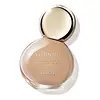Estée Lauder Double Wear Stay-in-Place Foundation Versus Guerlain L'Essentiel Natural 16Hr Wear Foundation SPF20
What's inside
What's inside
 Key Ingredients
Key Ingredients

 Benefits
Benefits

 Concerns
Concerns

 Ingredients Side-by-side
Ingredients Side-by-side

Water
Skin ConditioningCyclopentasiloxane
EmollientTrimethylsiloxysilicate
EmollientPEG/PPG-18/18 Dimethicone
EmulsifyingButylene Glycol
HumectantTribehenin
EmollientPolyglyceryl-3 Diisostearate
EmulsifyingMagnesium Sulfate
Tocopheryl Acetate
AntioxidantPolymethylsilsesquioxane
Methicone
EmollientLaureth-7
EmulsifyingXanthan Gum
EmulsifyingAlumina
AbrasiveSodium Dehydroacetate
PreservativeDisteardimonium Hectorite
StabilisingCellulose Gum
Emulsion StabilisingPropylene Carbonate
SolventPentaerythrityl Tetra-Di-T-Butyl Hydroxyhydrocinnamate
AntioxidantPhenoxyethanol
PreservativeIron Oxides
Mica
Cosmetic ColorantCI 77891
Cosmetic ColorantWater, Cyclopentasiloxane, Trimethylsiloxysilicate, PEG/PPG-18/18 Dimethicone, Butylene Glycol, Tribehenin, Polyglyceryl-3 Diisostearate, Magnesium Sulfate, Tocopheryl Acetate, Polymethylsilsesquioxane, Methicone, Laureth-7, Xanthan Gum, Alumina, Sodium Dehydroacetate, Disteardimonium Hectorite, Cellulose Gum, Propylene Carbonate, Pentaerythrityl Tetra-Di-T-Butyl Hydroxyhydrocinnamate, Phenoxyethanol, Iron Oxides, Mica, CI 77891
Water
Skin ConditioningC9-12 Alkane
SolventGlycerin
HumectantPropanediol
SolventPolyglyceryl-6 Polyricinoleate
EmulsifyingSilica
AbrasiveTitanium Dioxide
Cosmetic ColorantC15-19 Alkane
SolventVp/Eicosene Copolymer
Dicaprylyl Carbonate
EmollientPolyglyceryl-2 Isostearate
EmulsifyingCoco-Caprylate/Caprate
EmollientDisteardimonium Hectorite
StabilisingSorbitan Sesquiisostearate
EmulsifyingParfum
MaskingCaesalpinia Spinosa Fruit Extract
Skin ProtectingAlpha-Glucan Oligosaccharide
CleansingSodium Myristoyl Glutamate
CleansingStearic Acid
CleansingSodium Citrate
BufferingXanthan Gum
EmulsifyingAlumina
AbrasivePolyhydroxystearic Acid
EmulsifyingCellulose
AbsorbentPotassium Sorbate
PreservativeKappaphycus Alvarezii Extract
Skin ConditioningPolymnia Sonchifolia Root Juice
Skin ConditioningCitric Acid
BufferingButylene Glycol
HumectantAluminum Hydroxide
EmollientMaltodextrin
AbsorbentLactobacillus
Skin ConditioningTocopherol
AntioxidantTheobroma Cacao Seed Extract
AntioxidantCI 77491
Cosmetic ColorantCI 77492
Cosmetic ColorantCI 77499
Cosmetic ColorantCI 77891
Cosmetic ColorantCI 77947
Water, C9-12 Alkane, Glycerin, Propanediol, Polyglyceryl-6 Polyricinoleate, Silica, Titanium Dioxide, C15-19 Alkane, Vp/Eicosene Copolymer, Dicaprylyl Carbonate, Polyglyceryl-2 Isostearate, Coco-Caprylate/Caprate, Disteardimonium Hectorite, Sorbitan Sesquiisostearate, Parfum, Caesalpinia Spinosa Fruit Extract, Alpha-Glucan Oligosaccharide, Sodium Myristoyl Glutamate, Stearic Acid, Sodium Citrate, Xanthan Gum, Alumina, Polyhydroxystearic Acid, Cellulose, Potassium Sorbate, Kappaphycus Alvarezii Extract, Polymnia Sonchifolia Root Juice, Citric Acid, Butylene Glycol, Aluminum Hydroxide, Maltodextrin, Lactobacillus, Tocopherol, Theobroma Cacao Seed Extract, CI 77491, CI 77492, CI 77499, CI 77891, CI 77947
 Reviews
Reviews

Ingredients Explained
These ingredients are found in both products.
Ingredients higher up in an ingredient list are typically present in a larger amount.
Alumina is another name for the compound aluminum oxide. It is used as a thickener, absorbent, and abrasive.
As an absorbent, alumina can give a mattifying effect. It is used in mineral sunscreens to help coat nano-sized filters, such as titanium dioxide. By increasing the size of the UV filters, these ingredients stay on the skin for a longer time. By coating small sized ingredients, alumina helps thicken a product.
Alumina may be used as an abrasive, or exfoliant.
Alumina is naturally occurring in the mineral corundum. Certain varieties of corundum create rubies and sapphires. Corundum is also the crystalline form of alumina.
Learn more about AluminaButylene Glycol (or BG) is used within cosmetic products for a few different reasons:
Overall, Butylene Glycol is a safe and well-rounded ingredient that works well with other ingredients.
Though this ingredient works well with most skin types, some people with sensitive skin may experience a reaction such as allergic rashes, closed comedones, or itchiness.
Learn more about Butylene GlycolCi 77891 is a white pigment from Titanium dioxide. It is naturally found in minerals such as rutile and ilmenite.
It's main function is to add a white color to cosmetics. It can also be mixed with other colors to create different shades.
Ci 77891 is commonly found in sunscreens due to its ability to block UV rays.
Learn more about CI 77891Disteardimonium Hectorite comes from the clay mineral named hectorite. It is used to add thickness to a product.
It can also help stabilize a product by helping to disperse other ingredients.
Hectorite is a rare, white clay mineral.
Learn more about Disteardimonium HectoriteWater. It's the most common cosmetic ingredient of all. You'll usually see it at the top of ingredient lists, meaning that it makes up the largest part of the product.
So why is it so popular? Water most often acts as a solvent - this means that it helps dissolve other ingredients into the formulation.
You'll also recognize water as that liquid we all need to stay alive. If you see this, drink a glass of water. Stay hydrated!
Learn more about WaterXanthan gum is used as a stabilizer and thickener within cosmetic products. It helps give products a sticky, thick feeling - preventing them from being too runny.
On the technical side of things, xanthan gum is a polysaccharide - a combination consisting of multiple sugar molecules bonded together.
Xanthan gum is a pretty common and great ingredient. It is a natural, non-toxic, non-irritating ingredient that is also commonly used in food products.
Learn more about Xanthan Gum